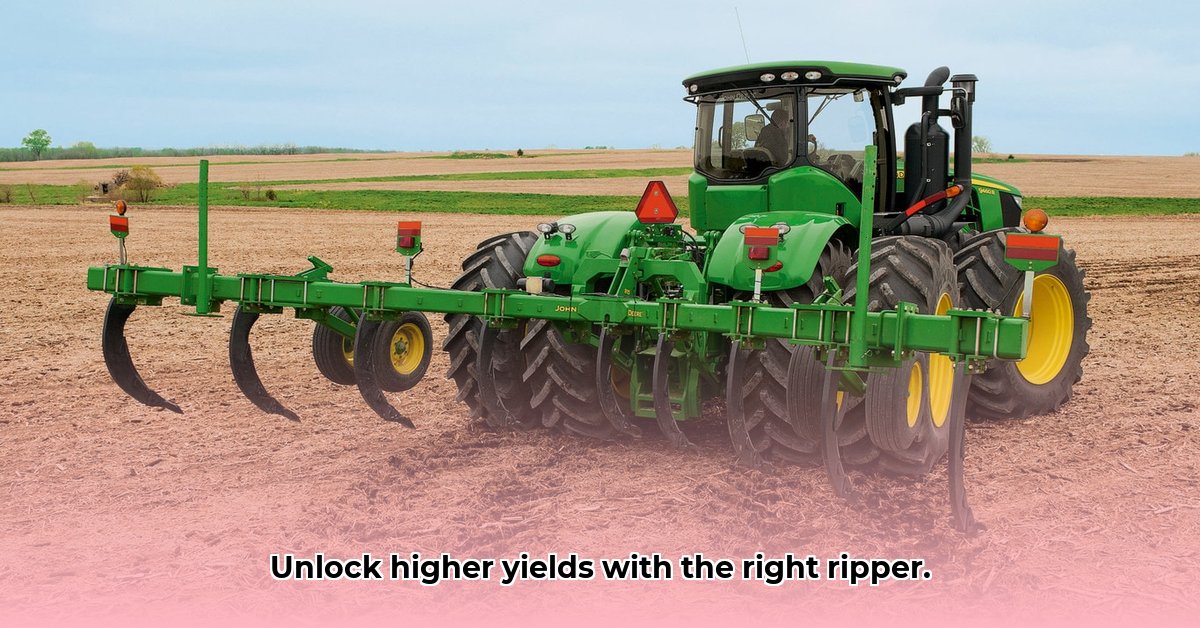
Choosing the right subsoil ripper is a critical investment for any farmer aiming for sustainable and efficient agriculture. This guide will help you navigate the selection process, comparing single-shank and multi-shank rippers based on key factors to ensure optimal soil health and increased yields. This isn't just about purchasing equipment; it's about optimizing your farming practices. For added tractor stability, consider tractor weights.
Understanding Your Soil: The Foundation of Your Ripper Choice
Before selecting a ripper, thoroughly assess your soil. Soil type dictates the appropriate ripper design and intensity needed. Heavy clay soils, prone to compaction, demand powerful, aggressive ripping, possibly requiring a multi-shank ripper. Lighter, sandier loam soils might necessitate a gentler approach with a single-shank model. Do you have significant areas of compaction that require breaking up? This is a vital question to answer before proceeding. A professional soil test can offer invaluable insights.
Single-Shank vs. Multi-Shank Rippers: A Comparative Analysis
The choice between single-shank and multi-shank rippers hinges on your farm's scale and specific needs. Consider them as specialized tools with distinct advantages:
| Feature | Single-Shank Ripper | Multi-Shank Ripper |
|---|---|---|
| Maneuverability | High; ideal for smaller fields and obstacles | Lower; best suited for large, open fields |
| Efficiency (Large Fields) | Lower; suitable for smaller-scale operations | Higher; optimized for large-scale operations |
| Tractor HP Requirement | Lower; less demanding on tractor power | Higher; requires a more powerful tractor |
| Initial Cost | Lower | Higher |
| Maintenance | Generally lower maintenance requirements | Potentially higher maintenance requirements |
| Soil Type | Adaptable to various soil types | Best for uniform, consistently compacted soils |
Single-shank rippers: These are highly maneuverable, making them ideal for smaller farms, fields with obstacles, or targeted treatments. Their lower cost and simpler maintenance are attractive features for smaller-scale operations.
Multi-shank rippers: These are designed for efficiency on large, open fields with uniform soil compaction. Their higher initial cost is offset by increased speed and productivity, proving cost-effective for larger farms. They dramatically reduce the time required to treat large areas of soil.
Key Factors Influencing Your Ripper Choice
Several crucial factors influence your decision. Let's examine them in detail:
Tractor Horsepower: Matching Power to the Task
Always match your tractor's horsepower to the ripper's specified requirements. Underpowering a ripper significantly reduces its effectiveness and can lead to equipment damage. Check the manufacturer's specifications diligently. Insufficient horsepower can severely hinder performance and increase the risk of costly repairs.
Farm Size and Scale of Operation: Right-Sizing Your Investment
Farm size directly correlates with ripper selection. Smaller farms (under 100 acres) generally benefit from the maneuverability of single-shank rippers. Larger operations (100 acres and above) often find multi-shank rippers more efficient due to their enhanced speed and coverage. The improved productivity can justify the higher initial cost.
Budget and Long-Term Maintenance: A Holistic View
Consider the total cost of ownership, including initial purchase price, ongoing maintenance (replacement parts), and fuel consumption. While single-shank rippers offer lower initial costs, the long-term efficiency of multi-shank rippers on large farms often outweighs this advantage.
Environmental Considerations: Sustainable Agriculture Practices
Sustainability is paramount. Opt for rippers made from durable, recyclable materials and designed for minimal soil disturbance. Consider fuel efficiency to reduce your carbon footprint and operating costs. Environmentally conscious choices demonstrate responsible farming practices.
Step-by-Step Guide to Choosing Your Subsoil Ripper
Analyze Your Soil: Perform a comprehensive soil analysis to determine type, compaction level, and drainage characteristics. A professional soil test is highly recommended.
Define Your Objectives: Clearly identify your goals; improved water infiltration, better root penetration, weed control, or a combination?
Assess Tractor Horsepower: Verify your tractor's horsepower to ensure compatibility with your chosen ripper model. Do not compromise on this crucial aspect.
Evaluate Farm Size and Layout: Consider field size, shape, and presence of obstacles that might affect maneuverability.
Develop a Realistic Budget: Include both upfront costs and potential long-term maintenance expenses in your calculations.
Thoroughly Research Ripper Models: Compare specifications, user reviews (both professional and farmer input), and consider demonstrating the equipment in your field conditions.
Consult with Experts: Seek guidance from experienced farmers or agricultural specialists for personalized advice.
Prioritize Environmental Impact: Select a ripper that minimizes soil disturbance and utilizes sustainable materials and manufacturing processes.
Choosing the right subsoil ripper is a crucial decision with a substantial impact on your farm's long-term success. By carefully considering these factors, you can make an informed choice that improves your soil health, boosts yields, and promotes sustainable agriculture for years to come.